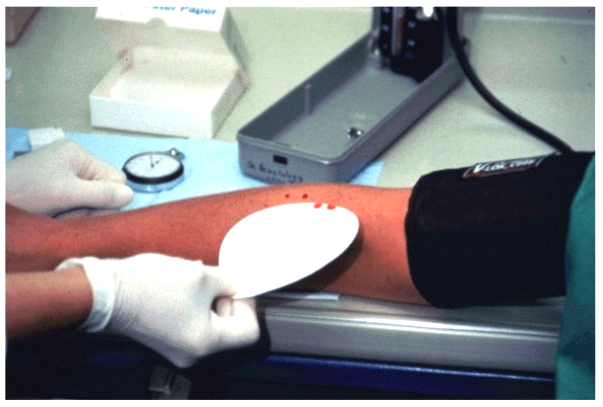Bleeding Time (BT)
Bleeding Time (BT) is the time by which bleeding stops from an injury site. Determination of Bleeding Time recognizes vascular defect and platelet disorder. Two methods are used for determination of BT - “Duke Method”, and “Ivy method”. In Duke Method, the incision is made on the earlobe or finger tips while in case of the Ivy method, the incision is made on the forearm under standardized conditions. Duke method is commonly followed in the laboratory of developing countries.
Clinical Significance :
Prolonged Bleeding time is generally found with thrombocytopenia (platelet count <50,000/µl) and where there is a platelet dysfunction. In case of Von Willebrond’s disease (This is hereditary condition caused by a platelet defect combined with factor VIII deficiency); Bleeding time is high with a normal platelet count.
Increases Bleeding time also found in some conditions like Hemophilia (A genetic platelet function defect is a condition present at birth that affects how well patient's platelets function), Primary thrombocythemia (a condition where Bone marrow produce excessive number of platelets), thrombocytopenia (a condition that causes production of platelets too low) & Pancytopenia (a condition that causes production of cellular component of blood is too low due to primary or secondary Bone marrow depression or dysfunction) etc.
Normal Value :
Duke method : 1 to 5 minutes.
Ivy method : 5 to 11 minutes.
Determination of Bleeding Time
by ‘Duke’ method
Principle :
A standard incision is made in the skin of the patient. The length of the time required for bleeding to cease is recorded.
Requirements :
- Doctor’s alcohol (70% ethanol)
- Sterile lancet or needle (24G)
- Filter paper (circular)
- Stop watch
- Cotton etc.
Procedure :
- Gently clean the finger tip with an alcohol sponge (cotton with alcohol). Do not rub, allow drying completely.
- Make a deep puncture with the sterile lancet or sterile needle (24G). start the Stop-watch. The blood should flow freely without squeezing the finger.
- Using the circular filter paper blot the drop of blood coming out of the incision every 30 seconds. Don’t allow the filter paper to touch the bleeding spot. Keep each subsequent drop a little further along the side of the filter paper; the drops become progressively smaller.
- When the bleeding ceases, stop the Stop-watch.
- Count the number of drops on the filter paper and multiply by 30 seconds.
- Report the closest minutes.
Note :
If the bleeding continues for more than 10 minutes, discontinue the test and apply pressure on the bleeding spot.
Determination of Bleeding Time
by ‘Ivy’ method
Ivy method is more reliable then the ‘Duke” method. In the Ivy method, the incision is made on the forearm under standardized conditions.
Principle :
A standard incision is made on the forearm under standardized conditions. The length of the time required for bleeding to cease is recorded.
Requirements :
- Doctor’s alcohol (70% ethanol)
- Sterile lancet or needle (24G)
- Filter paper (circular)
- Stop watch
- Cotton
- Sphygmomanometer.
Procedure :
- Banded the Sphygmomanometer cuff on the patient’s arm, above the elbow. Increase the cuff pressure and hold the pressure exact 40 mm of Hg for the entire period.
- Choose an area approximately three finger-widths below the bend in the elbow on the volar surface. Clean the area with Doctor’s alcohol (70% ethanol) with cotton.
- Hold the skin tightly by grasping the under surface of the arm firmly. Make two separate punctures 5 – 10 cm distance in quick succession using a sterile lancet. Start the Stop-watch.
- Blot the blood from each incision site on a separate piece of circular filter paper every 30 seconds intervals. The filter paper should not touch the incision site.
- When bleeding ceases, stop the Stop-watch and release the blood pressure cuff.
- Record the bleeding time of two punctures. The longer bleeding time in between two is given because the longer bleeding time is more accurate than the average of the two.
Precautions :
- Two standard incision are made on the volar surface of the arm where vein is absent.
- If the bleeding continues for more than 15 minutes, apply pressure to the wound site, stop the examination and report the result as “greater than 15 minutes”.






An excellent post, congratulations !!